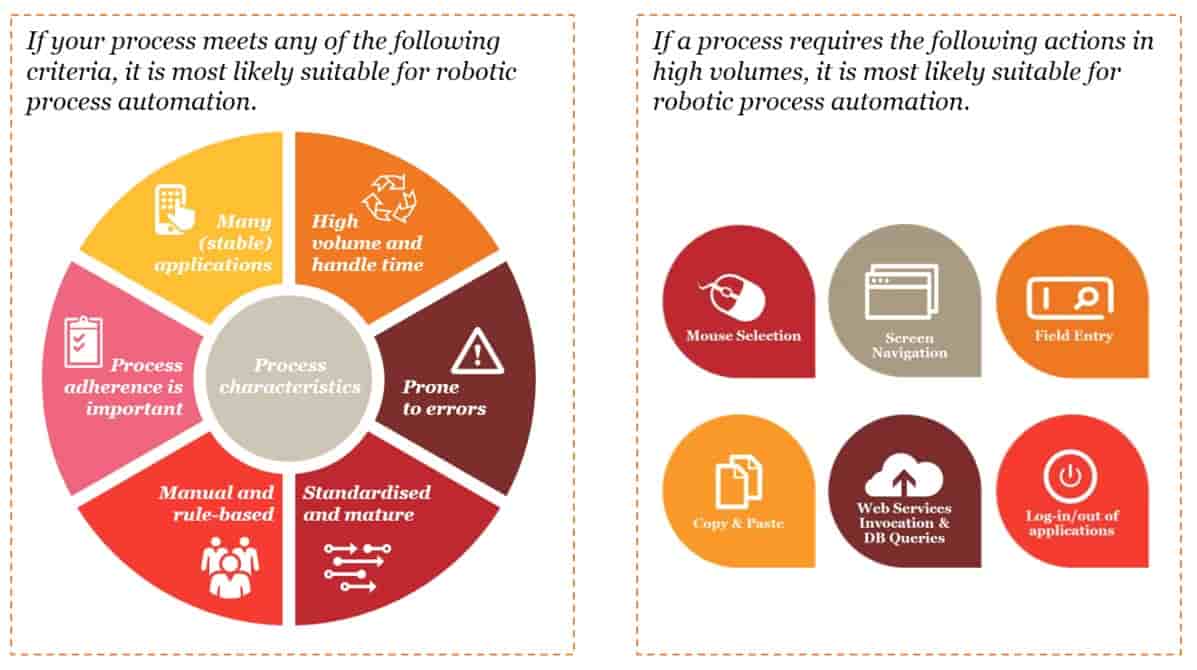- Blog
- What Does Robotic Process Automation Mean for Procurement and Finance?
What Does Robotic Process Automation Mean for Procurement and Finance?
How can your organisation implement robotic process automation (RPA) into everyday practices to simplify procurement and finance operations? Read more to learn how.
Robotic process automation (RPA) is one of the most-talked-about aspects of automation today. But while a few companies have created a proof of concept and some have even implemented RPA into their processes, most organisations don’t yet understand the full scope of what RPA can be used for or how to evaluate its potential for their own use.
RPA vs. automation vs. AI?
Those who aren’t familiar might be wondering exactly what RPA is and (if at all) how it differs from artificial intelligence (AI).


RPA isn’t like C-3PO from Star Wars. And it’s not something that can fully replicate humans. It’s helpful to think about RPA as virtual robots that integrate with existing software to replicate desktop actions that typically would be performed by a human. RPA is driven by simple rules and business logic — you have to tell the robots what to do.
AI, on the other hand, has the ability to review data, locate trends, and react accordingly based on past human actions. AI has the power, in this way, to identify and improve sourcing opportunities, better understand your data and supplier base, enter invoices and decrease manual exception handling, and turn process data into benchmarks.
Where and how can I use RPA?
Organisations can apply RPA to a multitude of processes across multiple functions and realise value quickly. From HR services to the supply chain, RPA can make an impact and all without necessitating the development of code.
There are three primary categories of RPA tools according to AI Multiple: programming options, cognitive capabilities, and usage. AI Multiple describes each category as the following:
“Programming options: RPA bots need to be programmed and there are a few ways to program bots which involve trade-offs between complexity of bots and programming time.
Cognitive capabilities: Programmed bots need to have cognitive capabilities to determine their actions based on inputs they gather from other systems. RPA tools provide a range of cognitive capabilities.
Usage: Bots serve specific functions. Though most RPA tools can be used to build bots that serve all these functions, some tools are more optimised for attended or unattended automation. While unattended automation is batch-like background processes, in attended automation users, for example customer service reps, invoke bots like invoking macros.”
To use RPA in procure to pay, look for activities that are labor-intensive, require accessing multiple systems, are repetitive, or that are audited for compliance periodically.
Some activities suitable for RPA are, for example:
-
Maintaining a vendor database
-
Acknowledging receipt of goods
-
Resolving price or quantity discrepancies
-
Establishing a date for payment
-
Updating the general ledger
-
Issuing checks
Could my organisation benefit from RPA?
While RPA is an established technology, its application to procure to pay isn’t. Some companies see the value, but they’re unclear whether their specific processes could benefit from RPA. If your process meets any of the following criteria or requires the following actions in high volumes as shown on the slide below, it’s likely that RPA could help you.
Process Characteristics:
-
Many stable applications
-
High volume and handle time
-
Prone to errors
-
Standardised and mature
-
Manual and rule-based
-
Process adherence is important
High-Volume Process Actions:
-
Mouse selection
-
Screen navigation
-
Field entry
-
Copy and paste
-
Web services invocation and database queries
-
Log-in/out of applications

 RPA improves businesses through the automation of business processes through inputs and business logic. And though in theory, RPA sounds great, the best way to fully understand its benefits and abilities is to see it in action.
RPA improves businesses through the automation of business processes through inputs and business logic. And though in theory, RPA sounds great, the best way to fully understand its benefits and abilities is to see it in action.
Consider the tedious task of data migration and forms processing. Usually, employees are the ones stuck pulling relevant information from legacy systems or manually entering data from paper forms. But RPA can support these efforts by reading the forms or entering the information – without introducing potential human error and while freeing up the employee to focus on more strategic tasks.
Consider, too, the difficult and sometimes overlooked process of updating vendor information in procurement operations. RPA can be used to update vendor information automatically through bots so procurement professionals can free up their plate to focus more on managing and improving vendor relationships.
How should I approach RPA?
First, focus on the importance of an end-to-end perspective when considering automation and RPA. McKinney estimates that 110-140 million full time employees could be replaced by automation software by 2025.
An organisation’s goal should be to put the following in place:
-
Standardised processes using automation technologies wherever possible
-
Consolidation into shared services and/or outsourcing
-
An integrated system used for purchase order creation, invoice processing, and electronic workflow for approvals
-
Compliance, fraud prevention, and detection measures
When companies are considering automation, it’s important to realise that RPA is one of many automation tools that they can use to fulfill functions that aren’t currently able to be handled by other solutions. RPA can be expensive. But if no other lower-cost automation solution is available, RPA can be a valuable tool.
And it’s a tool that companies are increasingly utilising. An Everest Group survey showed that 28% of respondents had already deployed RPA, while 40% said that RPA is the most enabling technology today.
How should I implement RPA?
First, know your processes. Having a clear picture and documentation of your manual processes is crucial for the success of the automation journey. Look at each of your processes for automation potential.
Next, start small. Don’t immediately jump into a large-scale automation project. Instead, aim for quick wins that will allow you to get a feel for implementation and simultaneously demonstrate value. At the same time, think wide. Your ultimate goal should be to standardise and automate your end-to-end operations, and you’ll want to have the end goal in mind from the beginning.
Finally, prepare your team. You need buy-in from each team member who will be involved. The more comfortable you can make them, the easier your implementation will be.
Why does RPA adoption fail?
Knowing the most common reasons why adoption fails will help you avoid the pitfalls. Here are the most typical causes of failure:
-
Focusing on “Should I use digital labor?” rather than “How can I use digital labor most effectively?”
-
Choosing the wrong processes with a weak first business case
-
Forgetting to think standardisation before automation
-
Not establishing the appropriate governance from the start with clear divisions of roles and responsibilities
-
Not incorporating the initiative into the current operating model
-
Operating in silos instead of cross-functionally with an end-to-end approach
-
Neglecting change management and the people aspect
-
Not finding the right competence profiles (business analysts, developers, SMEs)
These causes of failure don’t apply just to RPA. They can derail the adoption of any automation solution. You’ll need to look at all your processes and the improvements you want to make with these cautions in mind.
Predictions for RPA in 2020 and beyond
According to Gartner, Robotic Process Automation is the fastest-growing segment in the worldwide enterprise software market. By the end of 2020, Gartner predicts that RPA services will be valued at £5.98 billion.
Gartner predicted the top ten strategic technology trends for 2020—one of which is “hyperautomation.” They define this as “the combination of multiple machine learning (ML), packaged software and automation tools to deliver work.” This trend, according to Gartner, originated in robotic process automation, though RPA alone is not hyperautomation as hyperautomation requires a combination of tools to replicate human tasks.
Forrester shares similar views on RPA and its pervasiveness in 2020 and beyond. Forrester predicts that automation through means such as RPA will play a huge role in the future of work. They believe, “Tasks ranging from posting account ledgers to calculating HR benefits will be replaced by RPA (robotic process automation).” In this way, RPA will play an important role in changing the future of work and orienting it more towards critical thinking, strategy, and intellectual agility.
Related
-
By Basware RepresentativeUnveiling CFO Strategies for Long-Term Value Creation – Webinar Insights
-
By Anu HämäläinenUnlocking the Power of AI in Finance: A Dive into Invoice Ingestion Revolution
-
By Christopher BlakeComplexity to Clarity: Forrester's Expert Take on AP Invoice Automation
-
By Christopher BlakeChoosing AP Excellence: Finding the Right Solutions Amid S2P Suite Challenges
-
By Basware RepresentativeUnlock the Power of Invoice Digitalization: Watch Our On-Demand Webinar Now!
-
By Basware RepresentativeAP Metrics that Matter – Webinar with Ardent Partners
-
By Sanna EklundHarnessing AI and ML to Transform AP
-
By Basware RepresentativeWhen Is The Right Time To Move To Touchless Invoice Processing

